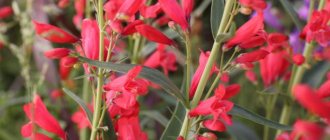Description of Physalis
Perhaps many do not know physalis by name, but everyone will probably recognize it externally. Physalis is translated from Greek as “bubble” and not by chance, because its shape resembles a growing cup or red-orange lantern. Although there are more than a hundred types of physalis, the most common are two: Mexican (vegetable) and sweet strawberry. There is also a decorative physalis that everyone is familiar with. You should be careful with it, because poisonous fruits are hidden behind its external attractiveness.
Strawberry fesalis
Physalis is known by many under other names, such as “earth cranberry”, “Chinese lanterns”, “emerald berry”, “dog cherry”, etc.
Wild physalis is found quite often in nature, but it is not as attractive as varietal physalis and is also quite toxic. Therefore, you should not transplant it to your garden plot. It is better to use the seeds of strawberry physalis, brought from South America. The fruits of this variety of physalis can be safely eaten in any form, as well as prepared “snacks”, decorated cakes and canned.
The fruits of the Mexican physalis can also be eaten, but using it in the preparation of other dishes. For example, how tomatoes are used in the preparation of sauces, hot dishes, added raw to salads, pickled, etc.
Types and varieties
Physalis edible is divided into physalis berry and physalis vegetable. The physalis berry is represented by such species as raisin physalis, or pubescent physalis, or strawberry physalis, Peruvian physalis, which has recently begun to be grown in the middle zone, and Florida physalis, as well as their varieties.
Physalis floridana
It has sweet, pleasant-tasting fruits without any fruity aftertaste and almost no acidity. The jam made from this type of berries resembles cherry jam, so when cooking, leaves of fragrant geranium are added to it.
Physalis pubescens
It has a more refined taste - sweet, with barely perceptible sourness and a pronounced taste and smell of pineapple. The juice of the fruit resembles tangerine juice. The fruits of this physalis can be stored for up to 3-4 months, or even up to six months, acquiring a slightly withered appearance over time. Dried fruits really resemble raisins.
Physalis peruviana
It is not as sweet as raisins, but the fruity taste and aroma of its fruits is stronger, and in terms of the amount of acids and sugar they contain, they are close to garden strawberries. Physalis berries of this species are too tender for long-term storage.
The best varieties of physalis berries include:
- Pineapple - early ripening physalis with miniature and sweet-tasting fruits with the aroma of pineapple, consumed both fresh and in the form of jam and candied fruits;
- Strawberry - bushes up to 70 cm high, on which amber sweet fruits with a strawberry aroma ripen, consumed fresh and dried, and also used for making desserts, compotes and jam;
- Physalis raisin Surprise is a low-growing, early-ripening and unpretentious annual with strong pubescence; Surprise fruits are good for fresh eating and as a raw material for desserts;
- Columbus is a tall, heat-loving and late-ripening variety, the berries of which are rich in vitamins, pectin and microelements. They are eaten fresh and made into desserts and drinks;
- Kudesnik is a variety with very large, flattened brown-orange, sweet and sour fruits with a slight grapefruit bitterness and a strong strawberry aroma. The berry juice tastes like orange juice, but has a brighter bouquet;
Mexican physalis (Physalis ixocarpa), or glutenous
Physalis vegetable is represented by the species Physalis Mexicana, or glutenous, and its varieties. The fruits of the vegetable physalis resemble tomatoes more than the fruits of other species. Among vegetable physalises, there are tall varieties, and there are also low, spreading ones. The fruits are yellow, green, and purple in color, and they vary in shape and size. Vegetable physalis are less demanding of heat and more productive, but when fresh they are not as tasty as berry ones. But they make excellent marinades, pickles, caviar and salads. The most famous varieties in the culture of the middle zone:
- Magnolia: planting and care in the garden, types and varieties
- Ground Gribovsky is a cold-resistant, mid-early productive variety with a bush height of up to 80 cm and semi-erect branches. Light green, sweet and sour in taste, the fruits weigh 60 g;
- Confectionery - a large-fruited mid-season variety with sour round fruits of light green or dark green color, which can not only be pickled, salted and made into caviar, but also used for making homemade desserts;
- Korolek is an early ripening variety that is used, like the Confectionery variety, for processing into desserts and canned vegetables;
- Moscow early is an early ripening variety with almost recumbent branches and sweet light yellow fruits weighing up to 80 g.
Physalis decorative
Chinese lanterns - represents species of herbaceous perennials. All its parts are not only inedible, but also poisonous, but it enjoys constant success among landscape designers. This physalis reaches its greatest decorative value in late summer or early autumn, when its boxes acquire a bright orange color.
Popular varieties:
- Franche - often this plant is cultivated as an annual. Physalis Franchet bushes reach a height of 90 cm, its leaves are oval, widened towards the base, up to 15 cm long. Up to 15 “lanterns” can form on one shoot, which are the fruits of physalis, dressed in bright cups;
- Alkekengi is also a type of decorative physalis with yellow, red or orange “lanterns”.
How to choose the right place
Choosing a place to plant physalis is a rather important stage. Its successful growth and development, as well as the harvest, depend on this.
We can briefly list the basic requirements for the planting site:
- the soil for growing physalis must be calcareous; physalis will not take root in acidic soils;
- Physalis should not be planted in soil in which nightshade plants previously grew: tomatoes, peppers, potatoes (less than 3 years old) in order to get rid of nightshade pests;
- the area should be well lit all day;
- Accumulation of melt and rain water on the site is unacceptable;
- Weed control is also necessary.
The soil on which various other crops, except nightshades, were previously grown, may be quite suitable for planting physalis.
And in areas with excess moisture (if there are no other options), you can make ridges of soil approximately 40-45 cm. height.
Physalis in a summer cottage
How to grow physalis from seeds in open ground
If the climate in the region where you are going to grow physalis is warm, then sowing the seeds can be done directly in open ground. Physalis is unpretentious and reproduces by self-seeding; all you have to do is thin out the plant, remove weeds and monitor its development.
Physalis seeds
The shelf life of the seeds is about four years. Before sowing, the seeds should be poured with a 5% salt solution and observed. Remove the seeds that float to the surface, and rinse those that remain at the bottom and pour in a saturated solution of potassium permanganate for 30 minutes. Then rinse and dry again. A more favorable period for sowing seeds in the soil is from April to early May. The soil also needs to be prepared before sowing the seeds, dug up thoroughly, to a depth of approximately 20 cm, so that the soil is filled with air. Apply fertilizers per 1 sq.m. – 30 kg of fertilizer. But this needs to be done in advance, in early spring. Immediately before sowing the seeds, make furrows; the row spacing should be approximately 0.3 m. There is no need to sow seeds densely. When shoots appear, thin out in time, keeping a distance of about 25-30cm.
Sowing Physalis seeds
To ensure a successful landing, follow these steps:
- Take a convenient container and make several holes in its bottom through which excess water will drain.
- Make drainage from small pebbles or expanded clay, and pour nutrient soil on top of it. There should be about 1 cm between the edge of the container and the substrate.
- Lightly compact the surface and then moisten with settled water.
- Make rows at a distance of 4 cm, their depth should not exceed 1 cm.
- Place the seeds in the grooves, leaving at least 2 cm between them. Moisten with a spray bottle and cover with loose soil.
- Cover the container with a transparent lid or film. Keep in a warm place until sprouts appear.
Ventilate the soil daily by opening the film for a short period of time. Having discovered the first shoots, immediately transfer the container to a lighted windowsill. Due to lack of light, the sprouts will quickly stretch.
How to grow seedlings
Most gardeners grow physalis through seedlings. Using this method of cultivation, physalis will begin to bear fruit much earlier than those sown directly in open ground. Seedlings are grown for a month or a month and a half before being planted on the site. Seeds are germinated in separate containers of approximately 0.5 liters. You can also sow seeds in convenient boxes using a 6x8 pattern. In this case, you can do without picking. Seed treatment before sowing is the same as when sowing in open ground. After sowing, the containers should be placed in a warm place, at least 20 degrees (in a cool place, seedlings will appear in a month). If everything is done correctly, then after seven days the long-awaited sprouts will appear.
Physalis seedlings
Now it is very important to properly care for the seedlings. Sprouts need diffused bright light and warmth. Air humidity and watering should be moderate, otherwise the plant may get sick.
Please note! Physalis does not like excess moisture and drafts!
If everything is done correctly, and the plant is not developing well, then there may be a problem in the soil, and the plant should be fed. A solution of water with bird droppings (in a ratio of 20:1) is considered a good feeding.
After feeding, the plants must be shed with water so that they do not get burned!
What is picking
Diving is the planting of seedlings from a common container into individual containers. If the seedlings turn out to be too thick, be sure to pick, otherwise they will not develop well. Picking is a very careful process and must be done carefully so as not to damage the root system of the plant. After each physalis sprout (and it must have at least two good leaf blades) has found its own cup, it can be grown until planting in the ground without additional diving.
When to plant seedlings in the ground
The seedlings must be well formed before planting them in the ground and have at least 5-6 leaves. But before planting seedlings, you should prepare the site. It should be well lit and the soil should be alkaline or neutral. Also, before digging, humus or wood ash is added to the soil in advance. The soil on which cucumbers or cabbage previously grew will be favorable. You cannot plant physalis in soil where nightshades previously grew: tomatoes, eggplants, potatoes, physalis, etc. (for at least 4 years). Since all nightshades are susceptible to infection by the same diseases, and their pathogens persist in the soil for a long time.
Please note! Fresh manure cannot be used to fertilize the site! (Manure has a decomposition period, without taking this into account, you can destroy the plant)
The advantages of growing physalis seedlings yourself
You can buy physalis seedlings or grow them yourself. When growing yourself, you are absolutely independent: you can choose among many varieties of seeds and regulate the number of plants. The time of sowing and planting in the ground depends only on you and the weather.
The leaves of physalis are similar to peppers and eggplants, it is not afraid of transplantation, like a tomato, the fruits are hidden in covers that protect against diseases
Physalis, like any cultivated plant, is divided according to ripening periods into:
- early - 90–98 days from germination to the start of harvest;
- mid-season - 100–120 days;
- late - 150 days.
Plants are afraid of spring frosts, but unlike tomatoes they are resistant to late blight and rot. The harvest can be harvested until the coldest weather.
Seeds are often sown directly into the ground, under temporary film covers. But if you sow in advance, in seedling boxes, you will reap more harvest. Physalis sprouts quickly and caring for the plant is very simple.
Strawberry, also known as raisin, and physalis are especially valued. It produces small fruits with a strawberry smell and sweet taste. The berries in the cases are stored all winter, dry out and are very reminiscent of raisins. The variety is suitable for making candied fruits and jam. In the USA, 1 kg of strawberry physalis berries is expensive - about 20 dollars - and is considered exotic.
What are the features of planting physalis?
As mentioned earlier, physalis has more than a hundred species, and each has its own characteristics!
Physalis on the terrace
Most species and varieties are highly branching. Taking these features into account, seedlings should be planted in a checkerboard pattern, at a distance of approximately one step (50cm). If you have tall varieties of physalis, then in this case you need to take into account the garter of the plants. The holes should be dug to such a depth that the plant is immersed up to the first leaf blade. Then, filling it with soil, water it well. Overgrown seedlings are planted in holes filled with water (1.5 liters) so that the roots are well straightened, and then covered with soil and compacted. It is very advisable to cover the surface with peat after planting the seedlings in the ground.
Peat is a limitless storehouse of organic matter and structural elements that help other soil types. Peat is formed over tens of thousands of years from the decomposition products of plant residues. It and the soils produced on its basis practically do not contain pathogenic and phytopathogenic organisms and fungi. There are also no parasites or viable weed seeds. Peat is an organic, natural, biologically pure product.
Vegetable physalis
A less cold-resistant species than the ordinary one, but capable of withstanding light frosts. In our area it is an annual. It is considered a cultivated species, the fruits of which are used by humans.
Belongs to the Mexican group of physalis, representatives of which were domesticated several thousand years ago. Due to sufficient cold resistance, it is planted in the ground several weeks earlier than tomatoes.
It is more resistant to diseases and pests of nightshades. Shows good resistance even to such a “killer of nightshades” as late blight.
This species is cross-pollinated, which makes it possible to engage in its selection, although there is practically no significant and fundamental work in this direction. Similar to the common one, by autumn the boxes of its fruits become bright orange or red.
The fruits themselves have a slightly different shade - they are mostly pale yellow, although there are exceptions. The main difference between ordinary physalis and vegetable physalis is the much larger size of the latter’s fruits.
Purple form of vegetable physalis
It is the vegetable physalis that can grow on stretch marks and supports up to 2 meters in height. It all depends on how to care for the plant. However, even without any care, the plant can reach a height of 1 meter.
The Mexican tomato, which is most widespread in Europe, has several dozen varieties, the most common of which are:
Early Moscow variety
It is a plant with a higher degree of branching, with predominantly recumbent stems. The foliage has an elongated oval shape, its color is light green. The flowers are distinguished by the presence of brown spots on a white and yellow background. The calyx covers the fruit almost completely.
The fruits are usually round in shape, their diameter is 40-50 mm, and their weight is about 60 g . Unripe fruits are green, turning yellow as they ripen; Sometimes ripe fruits have a yellow-amber hue.
Fruits of the Moscow early variety
The fruits of this variety have a sweet taste . The sour taste characteristic of many other varieties of vegetable physalis is practically absent. Ripens relatively early - in early or mid-summer. Productivity can reach 5 kg per square meter. m.
Variety Gribovsky ground
Despite the name, it is a relatively tall plant, growing up to 80 cm in height without supports . The leaves are dark green in color and oval in shape. The leaves are smooth to the touch. The flowers have an uncharacteristic green color and are covered with light brown spots.
The capsule containing the fruit covers it entirely. The veins are dark green, sometimes brown. The fruits themselves, even when ripe, are green. The weight of the fruit can reach 60 g.
Fruits of the Gribovsky soil variety
The fruits have a sweet and sour taste . It is a cold-resistant variety and can be stored for a long time. Productivity from 3 to 5 kg per square meter. m.
Confectionery grade
Created relatively recently, specifically for the needs of the confectionery industry. It is a plant with branching and spreading stems. The leaves have a dark green color. Flowers, fruits and boxes are light green. Fruit weight 50-60 g.
Confectionery grade
The taste is sweet and sour, the fruits can be stored for a long time. It is characterized by a high content of jelly-like substances.
How to care for physalis
Caring for physalis is very simple. Like any plants in the garden, physalis needs systematic watering, killing weeds and loosening the soil. Physalis also needs regular fertilizing, which must be applied to the soil correctly and carefully. Good fertilizers are organic fertilizers, which include a solution based on chicken manure in a ratio (1:15) or mullein (1:10). Fertilizing should be done after watering. Physalis does not like excessive moisture, so if the weather is not good, the plant will need to be hilled.
How to propagate physalis
The easiest way to propagate is to grow physalis from seeds and plant it. Physalis can also be propagated by cuttings and lateral shoots. The peculiarities of decorative physalis are the growth of a large number of shoots from a creeping rhizome, which is not deep in the soil. In spring or autumn, you can dig up part of the rhizome with developed shoots and plant it in a new place. Preparation of cuttings is carried out in the warm season (best in July), starting with cutting off the upper part of the shoots with 2-3 developed internodes and burying ½ of them in the ground for rooting. During this period, the plant needs additional care and is placed under a perforated film. They also provide systematic watering and protect from direct sunlight. When the plant takes root and regains its previous turgor, the film can be removed.
Mexican edible physalis
When growing physalis in open ground, do not forget that you cannot combine different varieties of physalis in one area. This will lead to crossbreeding of the plant, resulting in small and deformed fruits.
When to plant physalis according to timing and lunar calendar
The plant grows quickly, so in the southern regions physalis seeds are sown in April-May immediately in open ground. In the central zone of the country (Moscow region), in the Urals, and in Siberia, vegetable and strawberry species are grown through seedlings. For this purpose, crops are sown from February to April. This gap in planting time depends on the plant variety, each of which has its own ripening period:
- late varieties ripen in 150-160 days;
- mid-early ones will ripen 110-130 days after emergence;
- early - after 90-110.
But even late varieties are not recommended to be planted too early, otherwise at home the seedlings will outgrow, stretch out and become frail. Young plants are planted in the ground at the age of 30-45 days (depending on the variety).
It is better to sow late and mid-early varieties in March-early April, and early ones in mid- or late April. It all depends on the variety and weather conditions in your region. Seedlings should be planted after the threat of spring frosts or planted earlier by building a temporary greenhouse over them.
In order for physalis to ripen, it is recommended to choose mid-early and early varieties for areas with short summers.
To get an early harvest, some experienced gardeners plant in February. But in this case, after planting, the seedlings will need to be protected from frost or grown in a greenhouse.
Favorable days for sowing physalis seeds in 2021 according to the Lunar calendar:
- 12-14, 17-19, 22-23, 24 (until 15.00) February;
- 1-4, 16 (from 14.00), 17-18, 21 (from 15.00), 22-23 March;
- April 8, 9, 13-14, 18-19, 25-26;
- May 5-6, 12, 15-17, 22-25;
- June 1-3, 11-13, 18-22.
You will be interested to know: Effective ways to accelerate the ripening of tomatoes, peppers, cucumbers, watermelons and other fruits
Favorable days for winter sowing of physalis in the fall of 2021:
- 7-9, 16-17, 21-22, 26-27 October;
- 2-4, 12-14, 17-18, 22-24, 30 November.
How to deal with pests and diseases
Physalis is practically not susceptible to diseases. But due to improper care, the plant can get sick and die. A disease such as mosaic is a consequence of improper care. As a result, physalis leaves acquire a contrasting shade with dark green and light green spots. The number of fruits decreases by half.. And it is almost impossible to cure such a disease. To prevent the disease from spreading, the affected branches are separated along with the rhizome, dug up and destroyed. The remaining plants are treated and shed with a strong solution of potassium permanganate.
In areas with high humidity, physalis may be susceptible to blackleg disease. Signs of this disease: the stem at the base begins to turn black, then the plant dies. To prevent this from happening, you need to loosen the surface of the substrate in time, systematically thin out the seedlings, and water the plants correctly and only in the morning.
There is also such a common disease in nightshades as late blight. It is characterized by the formation of black or brown subcutaneous spots on nightshade fruits. I. occurs as a result of wet, rainy weather, especially when berries are forming. Fruits affected by late blight should not be eaten. An effective way to combat this disease is to spray the bushes with Bordeaux mixture (1%), but this must be done before the ovary forms!
Late blight is most often transmitted by potatoes and tomatoes. If these crops previously grew on the site, then physalis or other nightshades should not be planted in this place.
Fusarium is a fungal disease caused by fungi of the genus Fusarium. A plant affected by this disease begins to wither even before fruiting. Such a plant should be dug up, the roots and tops destroyed, and the soil disinfected.
Physalis can also be affected by various rots: white, gray. Signs of damage can be easily detected by examining the plant. It becomes covered with a whitish or gray coating, the calyxes of the plant crack and dry out, and the fruits rot. In such cases, you should carefully examine the plant in order to detect the disease in time and prevent its development. The plant should be treated with Bordeaux mixture, Ridomil or copper oxychloride during the growing season.
It is still necessary to fight diseases on physalis
Also, in addition to diseases, Physalis can be threatened by pests. Mole crickets and wireworms can damage the root system of the plant. To protect plants from mole crickets, use plastic bottles (2-3 liters). To do this, cut off the neck and bottom of the bottle, cut it in half and install the rings in the soil (having previously prepared the holes in the soil). Plants are planted in rings and covered with soil, but it is important that each ring rises at least 5 cm above the soil surface, then mole crickets will not be able to harm the young bush.
In the fight against wireworms, baits are used. To do this, dig holes around the perimeter of the site, put hay or rotted grass in them, cover them with boards and leave them for a day or two. After this, the bait is checked, everything is very carefully removed from the pit and destroyed. In the fall, the area is dug up very carefully so that all remaining larvae die in the winter.
Another pest is aphids. This insect is a carrier of late blight. To do this, the plant should be treated with insecticides several times during the season.
Physalis care (video)
How to prepare physalis for winter
We prepare perennial decorative physalis for winter in the autumn. The ground part is cut off. You can create wonderful winter bouquets from decorative physalis; for this, the leaf plates are cut off and the shoots with red-orange lanterns are dried in a hanging form. Before wintering, the soil on which physalis grew is sprinkled with a layer of mulch (peat).
Edible varieties of physalis, berry and vegetable annuals do not remain for the winter. After harvesting the fruits, the plant is destroyed and the soil is dug up.
Strawberry physalis
Another name for the plant is strawberry tomato or dwarf gooseberry. A low-growing plant with small-sized fruits. Belongs to the Peruvian group of varieties that appeared relatively recently.
Strawberry physalis
It is the most heat-loving species of all present in our climate, but, despite the fact that its fruits are more tasty than those of the vegetable physalis , it is not particularly widespread.
How to collect physalis seeds
2-2.5 months after transplanting physalis seedlings into open ground, approximately in August or September, harvesting begins. The fruits are picked together with dried calyxes in sunny weather. The berries do not all ripen at the same time, so those at the bottom may ripen earlier and fall to the ground on their own. These berries can be collected and used for cooking or simply eaten raw. You can extract seeds from them. To do this, the ripe berry is cut in half with a knife and both parts are immersed in water (preferably rain) for a day. The pulp can then be ground through a sieve, and the seeds are washed and dried.
Physalis fruit seeds
Useful properties and contraindications
Edible varieties of physalis are rich in useful substances such as proteins, carbohydrates, and fats. Contains dietary fiber, vitamins A and C, iron, zinc, potassium, magnesium, calcium, phosphorus, sodium, etc. It also has diuretic, hemostatic, antimicrobial, analgesic, choleretic, healing, anti-inflammatory properties. Using infusions, decoctions, and also consuming fresh physalis fruits, you can help treat urolithiasis. Also, you can treat bronchitis, edema, rheumatism, hepatitis, gout, cystitis, dysentery, hypertension, dermatosis, and simply improve your mood.
Carefully! The fruits of decorative physalis contain toxic substances: alkaloids and physalis, which can greatly harm the body.
Features of Physalis varieties
Ornamental physalis is a perennial. It is easy to care for and resistant to low temperatures, so there are no problems with growing this type of plant. Shoots with fruits in the form of lanterns of original shape are used to decorate rooms. If they are placed in flowerpots and not disturbed (a dry plant is very fragile), then they can delight the eye with their beauty for many years.
Vegetable physalis is resistant to low temperatures and has high yield. This type of plant is an annual, with large (up to 50 g) fruits. They are easy to store for a long time. Used for preparing salads, seasonings, and pickling. The varieties “Moscow Early” and “Korolek” have a sweetish taste, therefore they are the most cultivated in garden plots.
Physalis berry (strawberry) is a more heat-loving crop that produces small fruits (up to 8 - 10 g). They are consumed either fresh or used to make marmalade, jams, and preserves. The difficulty of breeding is that the ripening process takes longer than in other species of this plant. But this is fully compensated by the high taste qualities of the fruit, for which they are valued by gourmets.











